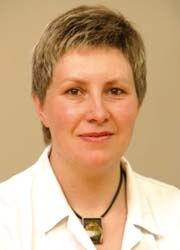Mammobiles encourage attendance of rural women
Among the most important EU guidelines for efficient breast cancer screening is the assumption that it is a low-threshold offer, which, after an initial start-up period, will include at least 70% of all women aged between 50 and 69. To ensure that this quota is met in areas that lack infrastructure, whilst also keeping personnel expenditure at bay, for the last few years mammobiles have toured Germany to screen women in their own vicinities.

Regions lacking infrastructure in former East Germany present particular challenges.
In the Thuringia area, for example, the geographical spread that needs mobile breast scanning facilities looks daunting. ‘We look after more than half of Thuringia. This is an East-West stretch of around 200 km, and a North-South distance of 150 km,’ explained radiologist Dr Susanne Wurdinger (above). With gynaecologist Dr Mathias Heiner, she is responsible for the screening programme in Germany’s biggest mammography unit, which has a target group of 180,000 women.
Apart from four stationary mammography units, the doctors and their team have two mobile examination trucks, the mammobiles. Although these are already in use, the doctors plan to expand the fleet; from September a third mammobile, with Hologic’s full-field mammography unit Selenia installed, will also tour Thuringia. Their choice of digital system was pragmatic: Dr Wurdinger explained that the resolution capacity and image presentation were immediately convincing. Additionally, experience has shown that the Selenia systems are functionally very stable – essential for equipment to be used at very high capacity*.
What encourages women to attend mobile screening? ‘Based on Dutch studies, we know that the closer the mammobile is to where they are based the more women attend screening,’ Dr Wurdinger said. ‘The “critical distance” above which the length of the journey gets in the way of potential attendance is a maximum of 12 km – pretty much exactly the maximum distance Dutch women are happy to cover by bicycle.’ She believes this is roughly the same as the situation in Germany: Anything accessible within a radius of 10 km is readily accepted. However, longer distances markedly lower willingness to participate in optional screening.
With their six mammography units, the team currently achieves a 54% participation rate — roughly on a par with the German average. The third mammobile should increase attendance towards the EU guideline figures. Apart from large distances, Dr Wurdinger has found that insufficient awareness training also affects attendance: ‘In some parts there is an overlap with the so-called “grey screening”, i.e. there is a certain group of women aged between 50 and 69 who have regularly been sent, and are still being sent, for mammographies by their gynaecologists. These women are supposedly covered and drop out of the official screening statistics. However, sometimes our invitations for mammographies are also mistakenly perceived as sales promotions and land in the bin. We need to make further efforts to improve the awareness of breast cancer among the general public and to work against any possible reservations about screening. This also includes ensuring that women know that breast cancer screening for the above mentioned target group in Germany is now fully reimbursed by the medical insurers, and that there is no fee – independent of whether they are being screened by a stationary mammography unit or in our mammobiles.’
The time between examination and the disclosure of results is not extended by the use of the mammobiles. The breast cancer specialists in Thuringia meet the EU guidelines, which state that each patient should receive results within a week of examination.
* Service and distribution of all Hologic equipment in Germany, Austria and Switzerland is run by Medicor. Medicor has a widespread service network and more than 20 technicians taking care of the clients. For more information please see www.medicor.de
01.05.2009










